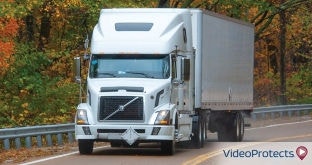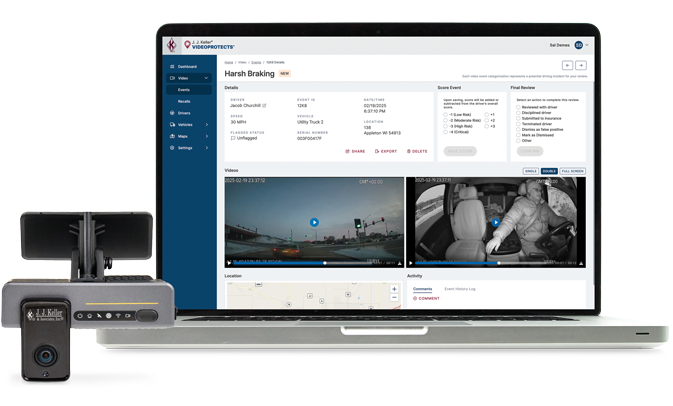Sr. Transportation Management Editor — J. J. Keller & Associates, Inc.
Improving Dash Cam Driver Acceptance and Retention
Coaching drivers can improve retention and enhance driver performance. Here are some ways to use dash cams to recognize good driving behavior, and improve driver safety.
Published On: 05/17/2024


Written by:
Mark Schedler
Carriers are rightfully concerned about doing anything that could increase the turnover of well-performing drivers. However, a coaching program can improve driver performance while reducing risk with a negligible impact on turnover.
The impact of coaching on retention, discipline, and turnover
Coaching newer drivers improves retention, enhances driver performance, and helps reduce terminations by positioning the carrier to help new hires early, keeping the little things little.
For example, consider new drivers who make a lot of mistakes. If they are not coached on how to correct their driving, they could reach the termination point or quit out of frustration. But when newer drivers receive coaching and correction early in their tenure, they become better drivers in critical driving skills and are ultimately, less frustrated. Most also recognize that the attention from their coaches and company is an investment into improving their safe driving and slow-maneuvering skills, which are essential to being a productive driver with a long tenure. Carriers with solid coaching programs have an attitude that video is like game film for athletes. It's there to help you perform better the next time.
However, coaches must follow progressive discipline and training policies. Fleet professionals cannot ignore the fact that a small percentage of drivers, after several attempts at fixing behavior, may not have the aptitude or perhaps the right attitude for professional driving. In these cases, termination is the only responsible course of action to manage risk. Terminating high-risk drivers is a small part of using dashcams for coaching.
Craft your dashcam policy on a foundation of trust and respect
A dashcam policy is a foundation for establishing driver trust and dashcam acceptance. Be clear that:
- Office personnel and drivers will be appropriately trained on the system and triggers.
- Videos are for driver training, loss prevention, and legal defense.
- Employee consent is required to use videos for other than individual coaching.
- Driver privacy is mandatory. Remote viewing of drivers is allowed only in an emergency.
- Recordings are safeguarded from unauthorized use or access.
- No images are stored unless an event trigger has occurred.
Implement your program thoughtfully and methodically
Implementing dashcams and the coaching program is a pivotal time for carriers. However, following these tips can help make the transition better for everyone. Consider these ten steps for a successful implementation of dash cams:
- Run a test period in small groups for at least two to three months.
- Consider a baseline period of two to three weeks with no coaching.
- Select locations with the highest risk-loss experience.
- Use driver feedback and union input to make adjustments along the way.
- Publicize wins of exoneration with driver privacy in mind.
- Utilize well-respected drivers and naysayers in the test groups.
- Be transparent and share results and feedback in town hall-style meetings.
- Be selective and train coaches to interact with the driver.
- Develop scorecards with a weighted average safety score and incentives for safe behavior.
- Focus on the goals of continuous improvement and protection of the business.
Use positive reinforcement to encourage desired behavior
Carriers can use dashcams and vehicle telematics metrics as a basis for reward programs for safe, high-performing drivers. Drivers can also be recognized for skillful maneuvers, which can only be accomplished with video. A video clip showing a lane departure or a hard brake can turn from potential counseling to an opportunity to recognize a driver since a coach will see what happened.
Innovative technology continues revolutionizing the transportation industry as fleets strive to improve safety metrics. Employee engagement deteriorates when cameras are primarily used as a disciplinary tool. Conversely, engagement increases when teams celebrate drivers who have consistently avoided incidents by being safety conscious.
If a driver avoids a crash or hits their metrics, public recognition and a "thank you" is warranted.
Talk with a specialist about how you can experience the VideoProtects™ Dash Camera and Video Event Management System, or contact your Geotab reseller today. VideoProtects not only provides an innovative dash cam solution, we collaborate with your team to provide a smooth transition for your drivers.

VideoProtects® Fleet Camera System
J. J. Keller’s VideoProtects® Fleet Camera System provides a full suite of safety features for improving driver safety and minimizing your fleet’s risk. Because it’s platform-independent, you can use it for any type of vehicles and with any fleet management software.
You may also enjoy the following articles:
Sign up for our newsletter!
We'll help you stay on top of regulations, best practices, and fleet industry news. Sign up to receive a monthly email notification with links to our most recent blog articles, free resources, and event invites.